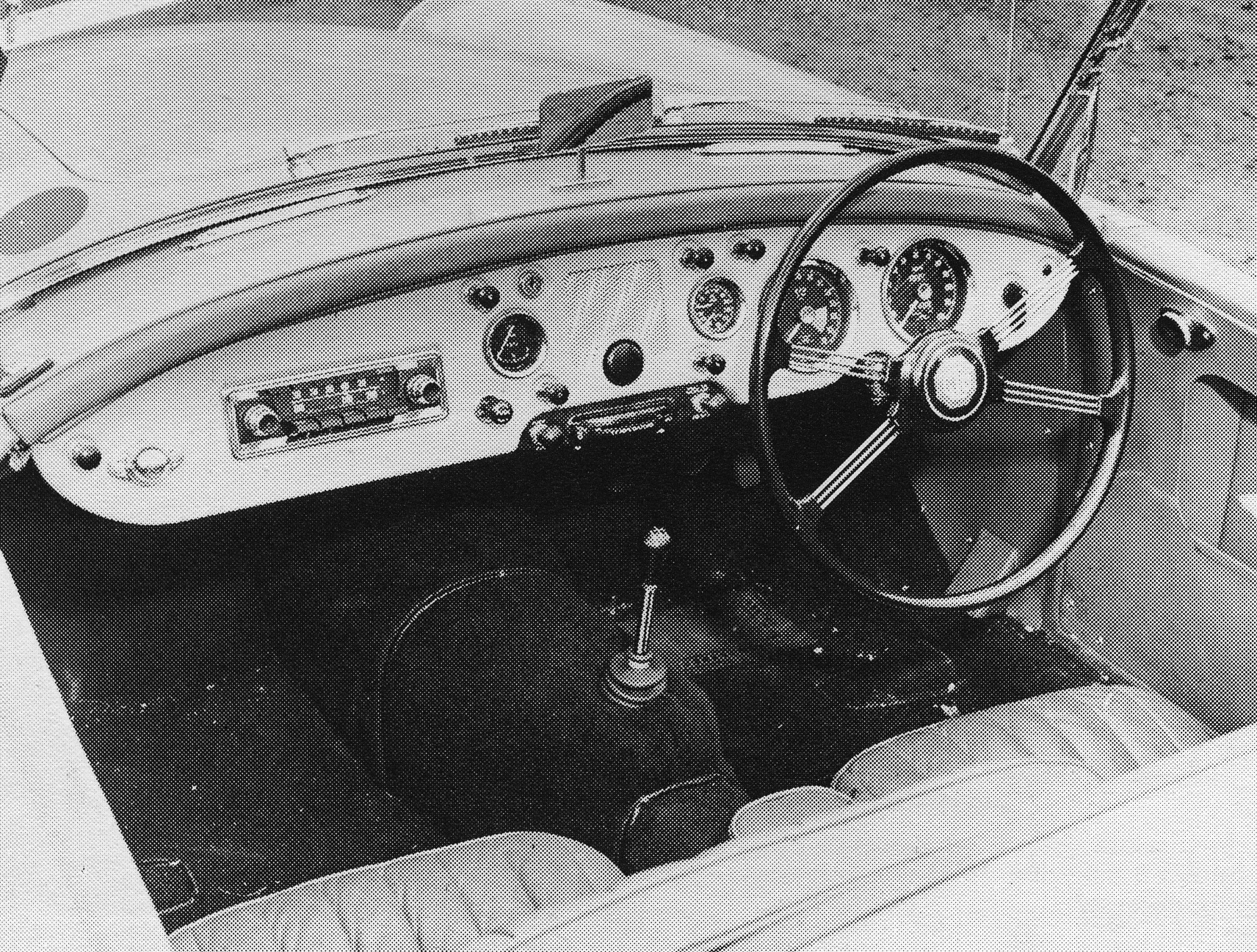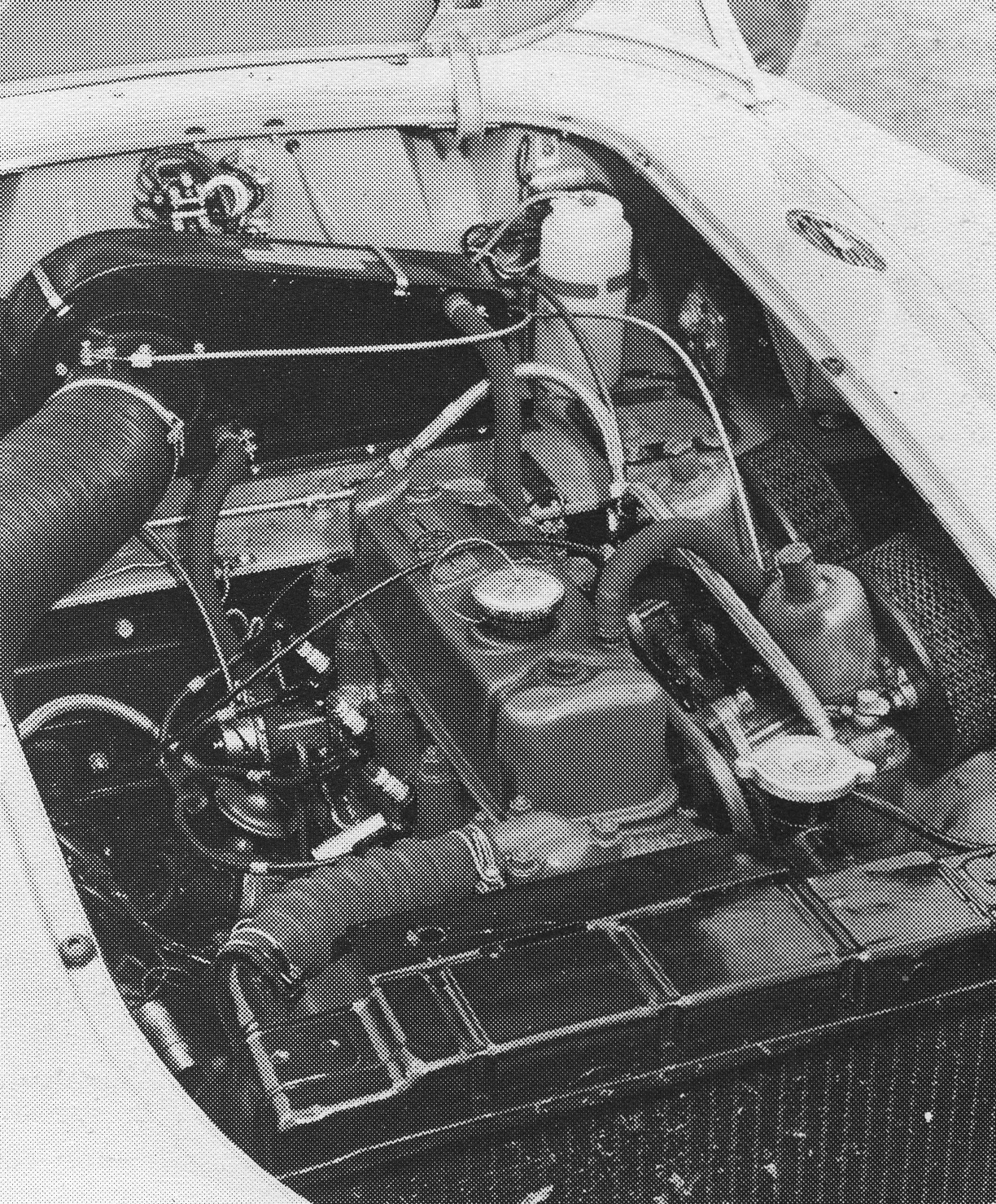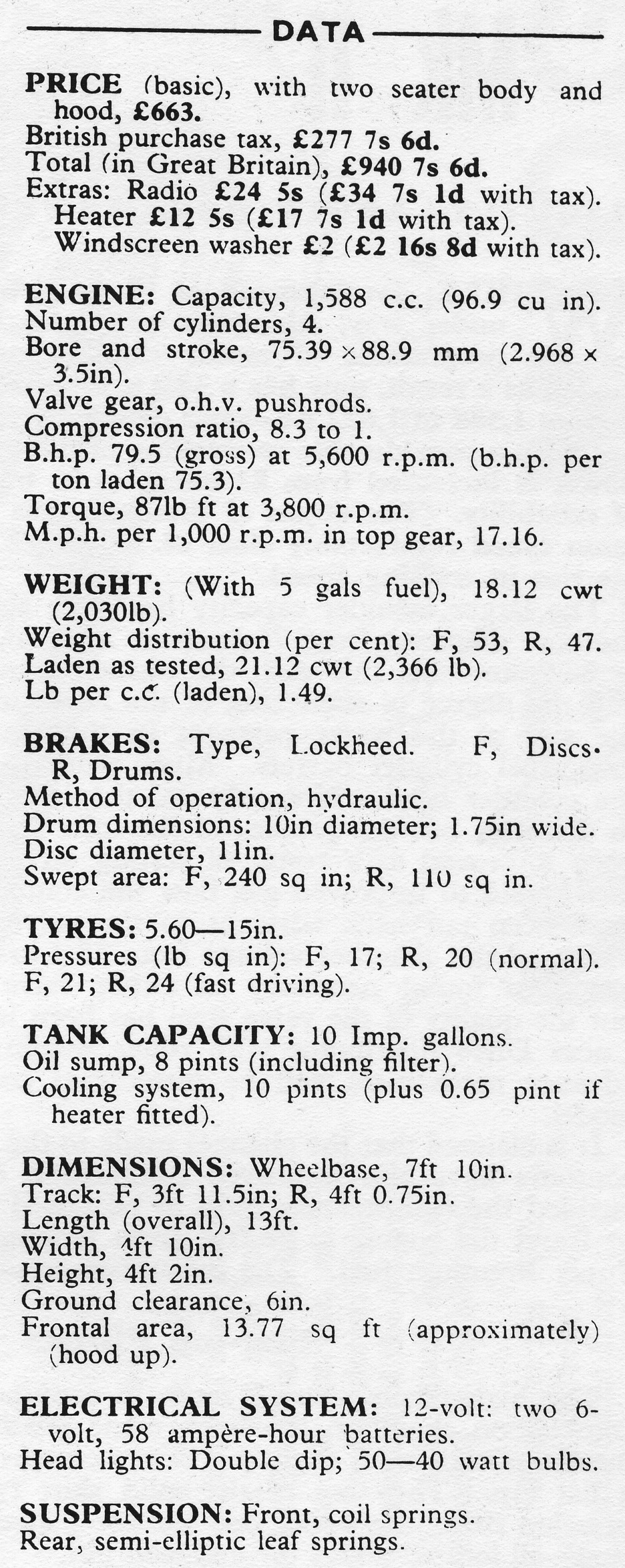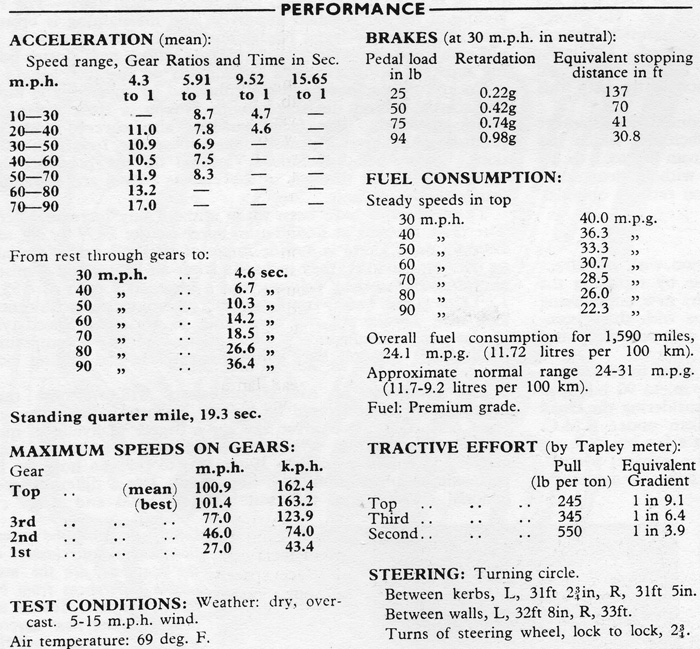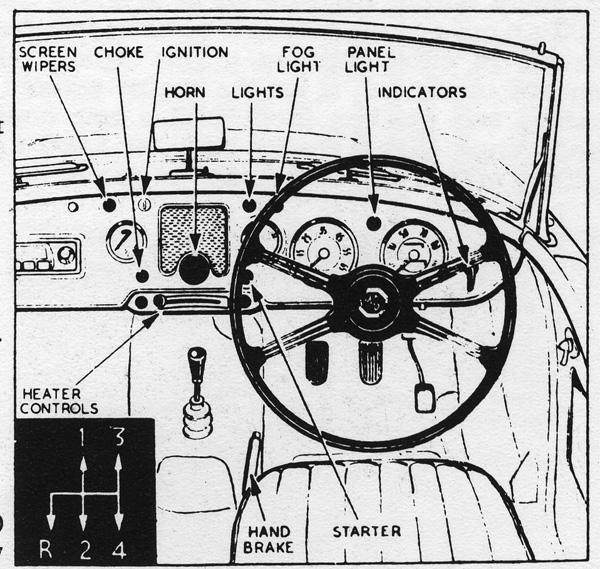
GB
IN the tradition of maintaining the breed, the new M.G. MGA 1600 is a direct successor to the MGA which, in its comparatively short existence, has become one of the most popular sports cars not only in England but also abroad. Indeed, as a dollar earner there are few cars which have done better. This new MGA is virtually identical except for an increase in engine capacity, the adoption of disc brakes at the front, and minor restyling attention to the body, including little 1600 motifs secured at either side near the bonnet louvres and on the boot lid.
With an engine capacity of 1,588 c.c. in place of 1,489 c.c., the gross power has been raised from 72 b.h.p. at 5,500 r.p.m. to 79.5 b.h.p. It 5,600 r.p.m. The effect of this increase is apparent as soon as one starts to drive the car, and there is no need of a stop-watch for evidence of the enhanced performance. Acceleration figures have improved over those of the previous model, and this is particularly noticeable in top gear at the higher cruising speeds. The figure for 50-70 m.p.h. in top gear has improved by almost 2sec, and the 60-80 m.p.h. figure by over 3sec. The car is capable of holding a genuine 100 m.p.h., but after several flat-out laps on a high-speed circuit it was noticed that the oil pressure was gradually dropping.
At 80 m.p.h., which. appears very quickly on the quite accurate speedometer, the car moves happily at a natural and comfortable gait. There was a tendency for the engine of the test car to become rough and to vibrate at about 5,000 r.p.m., but if the throttle pedal was held down this disappeared as engine speed continued to mount. Members of the staff with experience of the previous MGA feel the more powerful engine to be rather more noisy and harsh. This is unlikely to deter the true sports car enthusiast; nor is the. exhaust note. While not obtrusive at lower engine speeds, at 4,000 r.p.m. and above it is, perhaps, a little loud for town use, although the occupants of the car do not suffer from this so much as onlookers.
One of the greatest advantages of the new MGA is that the increased power has improved the flexibility of the engine, and where previously one had to use first and second while crawling in heavy traffic, one can now employ second and third gears quite comfortably. In fact, it was found that
the car would pull away from under 10 m.p.h. in top gear, though, of course, it is unlikely that any driver of this type of car would do so.
One. has to pay a price for these various benefits in a slightlv greater fuel consumption-24 m.p.g. overall for the 1,590 of the test. A gentle touring consumption which involved keeping the speed below 60 m.p.h. and avoiding high engine speeds in the intermediate gears returned a figure better than 31 m.p.g. During the test the car used three pints of engine oil, and the radiator needed considerable topping-up on two occasions.
When the car was delivered, the gear box proved to be extremely stiff; quite often it was necessary to employ both hands to engage reverse gear, and more effort than expected was required to select the other gears. Towards the end of the test, however, the movement had freed itself quite considerably, and it was obvious that in a thousand miles or so this would be a pleasant box to manipulate. Ratios are the same as those on the 1500 MGA, and one gained the impression that this car could have coped adequately with a slightly higher final-drive ratio. Smooth to operate, the hydraulically actuated clutch could contend comfortably with violent acceleration from a standstill with a minimum of slip.
While our previous experience of the MGA left us in slight doubt about the adequacy of the brakes relative to maximum performance, there is no doubt that the brakes of the I 600 arc of a very high standard indeed. With Lockheed discs at the front and 10 in drums at the rear, the car can be stopped repeatedly from its high cruising speeds very quickly without any trace of fade or loss of directional stability. For a maximum retardation stop a fair amount of pedal pressure is needed, but a mean efficiency of 98 per cent, without any tendency for the wheels to lock, is highly commendable. The comparatively high pedal loads arise because the braking system is not provided with servo assistance. The hand brake, of the fly-off type, is also powerful and held the car without trouble on a 1 in 3 gradient, from which incline the car moved away with plenty of power in hand.
By modern standards the suspension must be considered firm; on smooth roads this is, of course, 110 disadvantage, and the car could be really hurtled into corners, when it would go round with minimum fuss, sitting squarely on the road and feeling very safe and controllable during the whole performance. This did not apply on rougher surfaces, however, and a feeling that the wheels were hopping and jumping, accompanied by intermittent tyre squeal, indicated that the tyres were not maintaining full contact with the road. With standard tyre pressures there was some oversteer, but an increase in the [ear pressures reduced this to a bare trace at the sacrifice of a little ride comfort. The steering-rack and. pinion-had little self-centring action, but was commendably direct and precise. A degree of road shock was transmitted to the driver through the steering.
Body alterations centre round the restyling of the side, tail and turn indicator lights in order to bring them into conformity with new regulations in this country. The flasher lights on the front have been coloured amber, while at the rear the wing light units have been changed so that the turn indicators and rear lights are separate.
Side screens are now of the sliding panel type, and the manufacturers claim that these, with the hood up, give as much protection as a saloon car body. During the period that this car was on test the weather remained very fine and sunny, so that it was never possible to ascertain if rain would enter through the largish gap between the body and the leading lower- edge of the side screen. A series of pastel shades of paintwork is available for the 1600; the test car was finished in an attractive beige called Alamo.
Since no alterations have been made to the interior, much of what had been said before still applies-the spice provided inside is still cramped for a car of its dimensions. Well upholstered, leather-trimmed seats give moderately good support, and only for a very slim person is there any possibility of being insufficiently braced. A grab handle, incorporated in the windscreen mount~ is provided for the passenger. An average-sized. person found that he needed the driving seat in the fully back position to be comfortable, so that even' with an adjustable steering wheel a tall person never seemed really at home in the driving position, his arms being bent considerablv at the elbow. A fairly tall driver, however, has the advantage that his view of the - nearside wing is unobscured by the centrally mounted driving mirror. Gear change lever and handbake are convenient placed, but the facia-mounted horn button-old M.G. practice-is' not' always found when needed suddenly. Also it is unusual todav to find the ignition switch not incorporated with the starter control.
Mounted rather high, the dip switch needed a full stretch of the foot to operate, and the main beam warning light ,was obscured by the steering wheel. For normal cruising speeds the head lamps are entirely adequate, but if one were in a hurry more powerful beams would be desirable. The commodious door pockets are entirely adequate for all the odds and ends that normally find their way into more cars, but it is a pity when manufacturers do not provide in an open car which cannot be locked up, a thief-proof facia compartment. On the M.G. this facia space was occupied by a radio; although pleasant at town speeds, the set became practically inaudible as one accelerated away from speed limits. Wind noise on this car was marked when in open form, but became an irritating roar with the hood up; in the latter trim, visibility was not greatly restricted.
One person can erect the hood, but it is much easier for two; even then it is wise to anticipate rain if one is not to get wet. With hood and sidescreens stowed behind the seats it was rather difficult to reach the boot catch. Much of the small boot capacity is taken up by the spare wheel and tool roll-a flattish suitcase and an air travel bag are about the limit for stowable baggage, and they would have to be taken out to get to the spare wheel.
A quick glance beneath the bonnet would not encourage the private owner to carry out minor adjustments himself, but in fact most of the components which might need servicing or adjustment are fairly accessible. The M.G., with its powerful, responsive engine, combined with a moderately heavy but low-slung chassis, adequate steering and superlative brakes, and without any little vices or unpredictable traits in behaviour, maintains the traditional high standards of performance and safety of the marque.
Author: ArchitectPage

